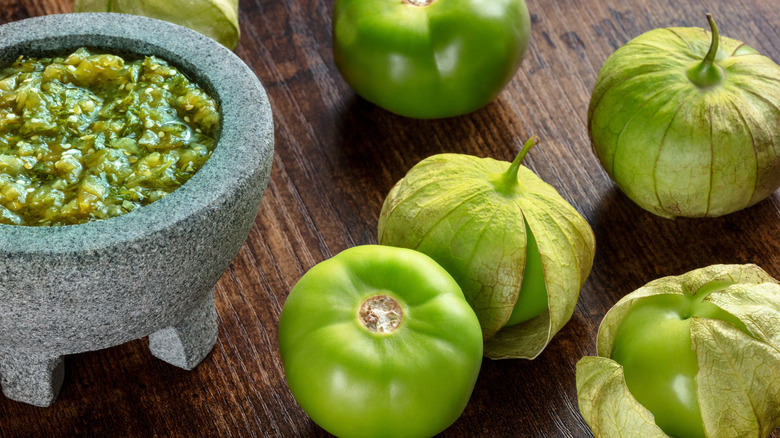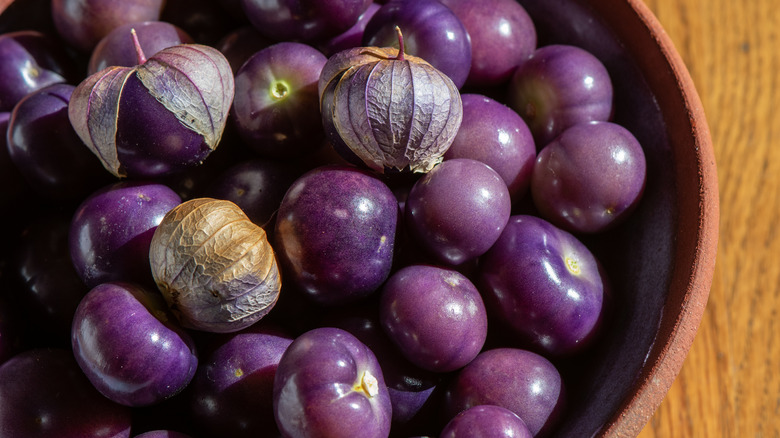What Makes Tomatillos Different From Tomatoes?
Anyone familiar with Mexican cuisine knows of the tomatillo, the tangy lead ingredient in salsa verde, tomatillo soup, green enchiladas, and more. When the dry, papery leaf husk is peeled off these small fruits, they very much look like tiny, unripe tomatoes. Their name even means "little tomato" in Spanish. Both tomatoes and tomatillos are incredibly versatile, as they can be roasted, stewed, pulverized into a sauce, and eaten raw. This leads many to believe that these tasty fruits are closely related, but their similarities are really only in name and appearance.
Tomatillos and tomatoes are distant cousins in the nightshade family of plants, which also includes bell peppers, eggplants, and potatoes. Compared to tomatoes, the Chinese lantern fruit and the cape gooseberry are far more closely related to the tomatillo. All the three are similar in size and feature similar leafy husks. And unlike actual green tomatoes, which have a bitter taste, tomatillos are much zestier, with a refreshing sour and sweet flavor.
Tomatillos are perfect for condiments such as a mango-tomatillo guacamole, where their unique acidity can really shine. Still, given that tomatillos aren't as popular as tomatoes in some countries, you may wonder about other uses for these flavorful green gems.
Some dishes work with either tomatillos or tomatoes, but others don't
Salsas are by far the most common way to use tomatillos. Whether boiled, roasted, or left raw, many recipes mix this fruit with the bright flavors of cilantro, chili peppers, and garlic. A tomatillo sauce can then be used to top off a variety of Mexican recipes, including chilaquiles, enchiladas, and huevos rancheros.
However, you shouldn't use tomatillos as a tomato replacement in recipes such as pasta sauces, as the sharp, citrus-y flavor of this fruit won't create the intended flavor. Likewise, tomatoes are not a great replacement for tomatillos in salsa verde or tomatillo soups, as they are way too mellow. Raw tomatillos are also way more crisp and firm than a soft, juicy tomato, so expect a much different mouthfeel if you plan to swap one for another.
This doesn't mean that tomatoes and tomatillos can't play similar roles. Roasted tomatillo slices pair just as well with meat as roasted cherry tomatoes would. Their sour overtones cut through the heavy, hearty flavors of steak or roast chicken. In chilis, pozoles (hominy-enriched soups), and stews, both of these fruits can brighten up the flavors of ingredients like meat, dairy, and hot peppers. You can also swap in tomatillos for tomatoes in salads or sandwiches. Try dressing them with olive oil and a simple vinaigrette, or try a smoky jalapeño grilled cheese with tomatillos, and enjoy how the acidic, savory, and spicy flavors meld in your mouth.
Tips for selecting and storing tomatillos
Unlike with tomatoes, color does not dictate the ripeness of tomatillos. In addition to green, you might be lucky to find yellow and even purple versions of this fruit, but all varieties should be judged mainly on texture. A good tomatillo will feel sturdy in your hand, and unlike a tomato, it will not yield to the touch. Any mushiness indicates decay, so keep an eye out for bruised or particularly soft tomatillos while shopping.
Once purchased, tomatillos will last about two days on the counter, three weeks in the fridge, and up to six months in the freezer. The counter works best for unripe tomatillos whose husks have not fully opened, and freezing should be relegated to fruits that you've already peeled, washed, or chopped.
As for the flavor of yellow and purple tomatillos, they are much sweeter in comparison to green breeds, and their flavor can resemble fruits such as plums or honeydew. These two uncommon variants are best served raw, as heat can ruin their flavor. For instance, they can actually substitute for tomatoes in a basil and mozzarella salad, to great effect. The dish's stunning appearance will wow anyone who tries it. Still, remember that no tomatillos are all that similar to tomatoes, much less identical — tomatillos deserve appreciation all on their own, without comparisons to their distant cousins.



